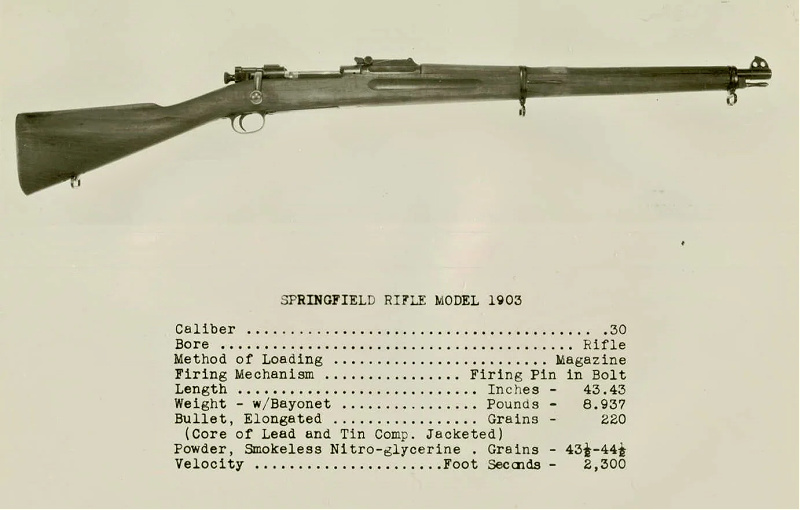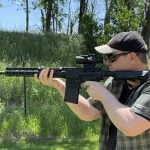From the hunt for Pancho Villa to the Battle of Guadalcanal, and beyond, America’s first 20th Century military rifle served in countless conflicts around the world.

The US Rifle, Caliber .30, M1903, commonly referred to as the M1903 Springfield, was the first new-design rifle utilized by the United States military in the 20th Century. As the nomenclature suggests, it was initially adopted in 1903. It came during a period of rapid development in the world of small arms, at a time when the United States was struggling to keep up with the great powers of Europe.
Previously, American troops were equipped with a variety of legacy weapons. The Army issued several variants of the Model of 1892/96/98 Krag-Jorgensen rifle. The Navy and Marine Corps, on the other hand, utilized the M1895 Lee Navy rifle. There were not sufficient quantities of either rifle available at the outbreak of the Spanish-American War in 1898, and many soldiers were issued then-obsolete Trapdoor Springfield rifles as a stop-gap.
The Spanish-American War, especially the fighting in Cuba, was grimly educational for US military planners. The Mauser Model 1893 rifles utilized by Spanish Regulars proved superior to their American counterparts. At the famous Battle of San Juan Hill, 750 Spanish soldiers, equipped with Mauser rifles and Maxim machine guns, delayed the advance of 15,000 American troops. They were able to inflict some 1400 casualties upon the attacking Americans in a matter of minutes.
A US Army Board of Investigation was commissioned in the aftermath. Examining the Spanish Mausers, they determined them to be superior rifles and recommended that the Krag rifle be replaced. The first prototype of this new rifle, built by the US Armory and Arsenal at Springfield, was tested in 1900; a second variation was developed a year later. A little more tweaking, including shortening the barrel to 24”, and the rifle was accepted by the US Army in 1903. It was chambered in a new, .30-caliber cartridge, colloquially called .30 Government.
Although Springfield Armory made several changes to the design during development, the M1903 was, in fact, a copy of the Mauser design. Mauser Werke brought suit against the United States government and won in court; they were later paid a quarter of a million dollars in royalties.
The rifle went through more changes early in its service life. The initial run of M1903s used a sliding rod-type bayonet that could be stored in the handguard. President Theodore Roosevelt (himself a veteran of the Battle of San Juan Hill) was not impressed with the design. He tested one personally and managed to break it. Afterward, he wrote a brief letter to the Secretary of War, insisting that the design be changed. In it, he stated:
“I must say that I think that ramrod bayonet is about as poor an invention as I ever saw. As you observed, it broke short off as soon as hit with even moderate violence. It would have no moral effect and mighty little physical effect.” A traditional knife-type bayonet, the Model of 1905, was subsequently adopted, and new-production M1903 rifles incorporated a normal bayonet lug. The sights were also altered for improved durability.

The biggest change that occurred during this retooling of production was the adoption of modernized ammunition. The original .30 Government cartridge fired a 220-grain, round-nosed bullet at 2,300 feet per second. This was replaced with a 150-grain, pointed (Spitzer-type) bullet, and the velocity was increased to 2800 feet per second. The new cartridge, first adopted in 1906, became known as the .30-06 Springfield and is still in production today.
The M1903 then went into full production and began slowly to replace the legacy service rifles of the Army, Navy, and Marine Corps. Its first operational test came in 1916, during the Mexican Expedition. The Mexican revolutionary leader Francisco “Pancho” Villa, angered that the US government had recognized his rival as the rightful leader of his country, led a raid into the United States. On March 9th, 1916, he attacked the town of Columbus, New Mexico, and nearby US Army outpost Camp Furlong. His forces killed 18 Americans, burned the town, and retreated back across the border with captured horses, mules, machine guns, and ammunition. The Punitive Expedition was ordered by President Woodrow Wilson in the aftermath.
A small percentage of M1903s in this period were equipped with Warner & Swasey Model 1908 and 1913 telescopic “Musket Sights”. This early 5.2x scope saw limited use in both the Mexican Expedition and the First World War, but was withdrawn from service in the 1920s.

The M1903 would soon be on the front lines again. In 1917 the United States formally declared war on Germany, becoming an active combatant in the Great War that had ravaged Europe for three years.



A variation called the Mark 1 was put into production, having been modified to accept the Pedersen Device. This device effectively turned the rifle into a rapid-fire submachine gun. While 65,000 of them were produced, the war ended before they could be fielded and the devices never saw combat.
Ian from Forgotten Weapons briefs you on the Pedersen Device.
The rifle soldiered on after the Great War and was used in numerous conflicts. It saw extensive service in Central America and was used by the Navy and Marines in China in the 1920s.
With the adoption of the M1 Garand rifle in 1937, the M1903 Springfield was formally replaced. However, by the time America entered the Second World War in late 1941, the military was in the same position it had been in during the Spanish-American War decades earlier: it didn’t have nearly enough of the new rifle to equip its forces. Existing M1903 inventories were insufficient for the war effort as well, and the venerable ’03 was put back into production to meet demand. Large numbers were produced by typewriter companies Smith-Corona and Remington. Alongside its semiautomatic replacement, it served in every theater of the war.

Wartime production saw some modifications to the M1903. The M1903A1 was supplied with a pistol grip stock (called the “C-Stock”). Machined parts were replaced with stamped steel ones, and the high-grade, walnut stock was replaced with one of lower-quality (but still serviceable) wood. Enough changes were made to production that the Army gave the new version its own nomenclature: M1903A3. Other changes included replacing the ladder-type rear sight with a simpler aperture type mounted on the receiver. Some were even manufactured with simplified “War Emergency Barrels,” the rifling of which only had two grooves. Over a million new M1903s were produced during the war, and many were used to equip US allies around the world.

The Springfield rifle was also pressed into service as a sniper rifle during the war. One variant, the M1903A4 was a dedicated sniper model adopted by the US Army. The M1903A4 was generally issued with a pistol grip C-Stock, but some had a semi-pistol-gripped version. The rear sight was removed to make room for the scope mount, and the receiver was modified to accept it. (Usually, the front sight was omitted as well.) The first scope it was supplied with was a Weaver M73 model, featuring a mere 2.75x magnification. This optic suffered from poor waterproofing, among other issues, but was in service until the end of the war. Other optics were tried as well, but the M1903A4 was eventually superseded by the M1C Garand.


The end of the Second World War was not the end of the M1903’s service life. The United States supplied South Korean forces, which used them extensively in the Korean War. Some M1903A4 sniper rifles were still in the inventory as late as the beginning of the Vietnam War.
By the mid-20th Century, however, the era of the bolt-action infantry rifle was over. Many M1903s were deactivated and used for drill and ceremonies for decades to come.

Many more were sold off after World War 2, allowing countless Americans to get a rugged, reliable rifle for a low price. Many of these were “sporterized”, modified to suit the preferences of hunters, including modifying the stocks and installing aftermarket optics mounts. Today, original, unmodified M1903 rifles are prized collector’s items and command premium prices. If you own one, you own a genuine piece of American history. The rifle, while obsolete as a military arm and at least 77 years old, will still get the job done if you need it to. As the late Jeff Cooper liked to say, “there ain’t many problems that a man can’t fix, with seven hundred dollars and a thirty-ought-six.”


